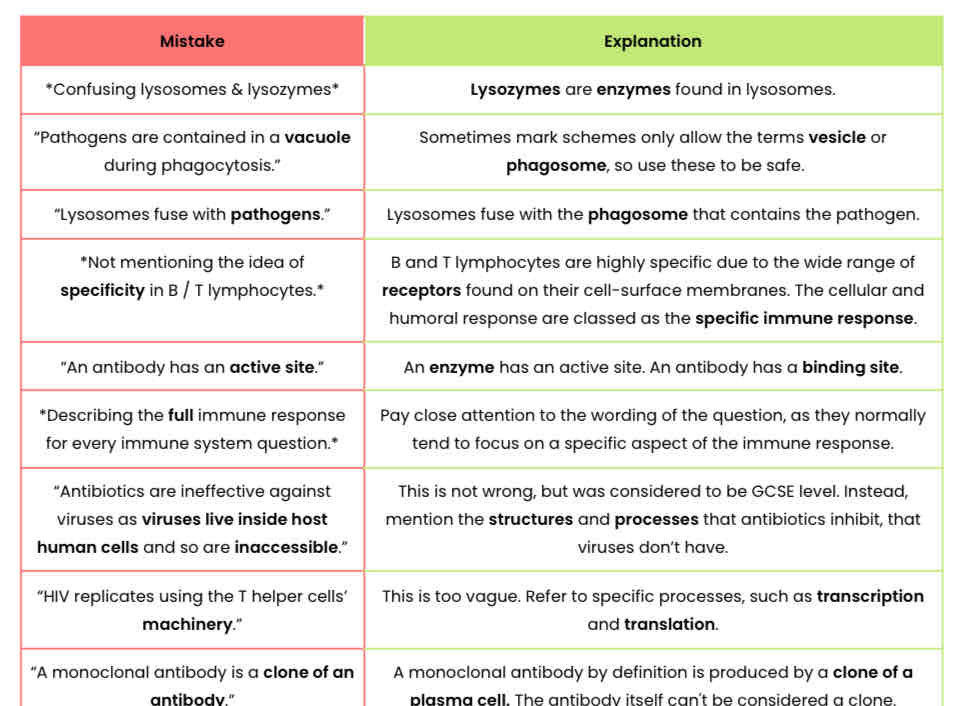Cells
1/93
Earn XP
Description and Tags
Name | Mastery | Learn | Test | Matching | Spaced |
|---|
No study sessions yet.
94 Terms
What are the distinguishing features of eukaryotic cells?
● Cytoplasm containing membrane-bound organelles
● So DNA enclosed in a nucleus
Describe the general structure of eukaryotic cells
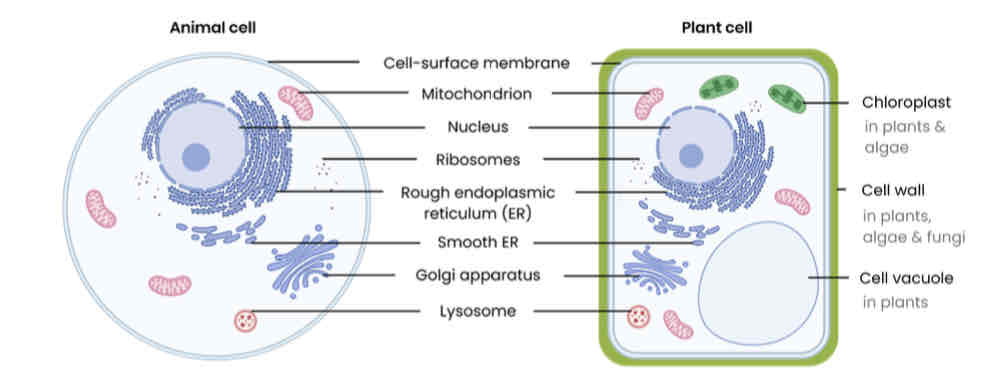
Describe the structure of the cell-surface membrane
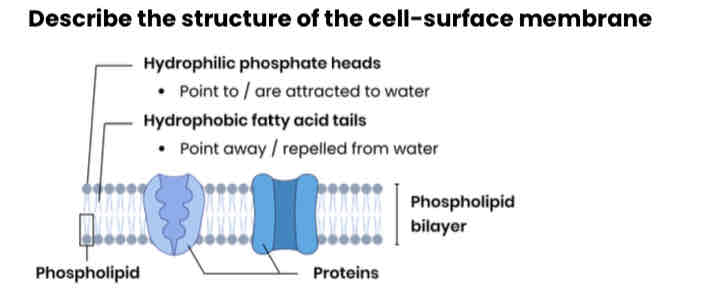
Describe the function of the cell-surface membrane
● Selectively permeable → enables control of passage of substances in / out of cell
● Molecules / receptors / antigens on surface → allow cell recognition / signalling
Describe the structure of the nucleus
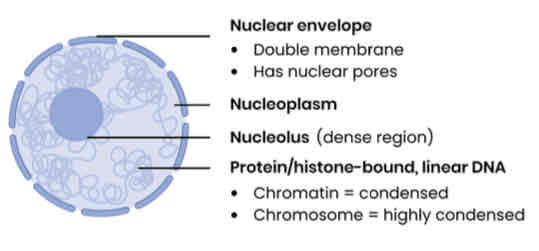
Describe the function of the nucleus
● Holds / stores genetic information which codes for polypeptides (proteins)
● Site of DNA replication
● Site of transcription (part of protein synthesis), producing mRNA
● Nucleolus makes ribosomes / rRNA
Describe the structure of a ribosome
● Made of ribosomal RNA and protein (two subunits)
● Not a membrane-bound organelle
Describe the function of a ribosome
Site of protein synthesis (translation)
Describe the structure of rough (rER) & smooth endoplasmic reticulum (sER)
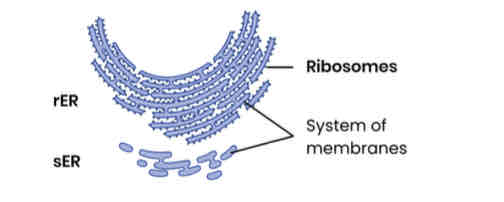
Describe the function of rER and sER

Describe the structure of Golgi apparatus and Golgi vesicles
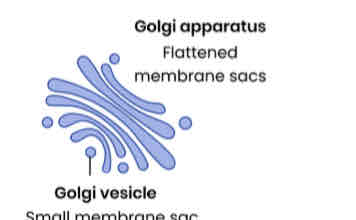
Describe the function of Golgi apparatus and Golgi vesicles

Describe the structure of lysosomes
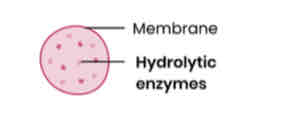
Describe the function of lysosomes
● Release hydrolytic enzymes (lysozymes)
● To break down / hydrolyse pathogens or worn-out cell components
Describe the structure of mitochondria

Describe the function of mitochondria
● Site of aerobic respiration
● To produce ATP for energy release
● Eg. for protein synthesis / vesicle movement / active transport
Describe the structure of chloroplasts in plants and algae
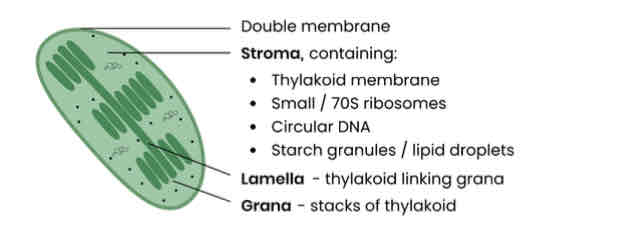
Describe the function of chloroplasts in plants and algae
● Absorbs light energy for photosynthesis
● To produce organic substances eg. carbohydrates / lipid
Describe the structure of the cell wall in plants, algae and fungi
● Composed mainly of cellulose (polysaccharide) in plants / algae
● Composed of chitin (a nitrogen-containing polysaccharide) in fungi
Describe the function of the cell wall in plants, algae and fungi
● Provides mechanical strength to cell
● So prevents cell changing shape or bursting under pressure due to osmos
Describe the structure of the cell vacuole in plants
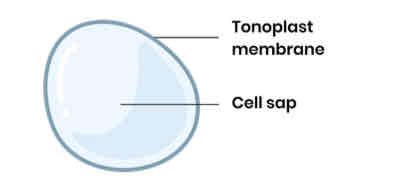
Describe the function of the cell vacuole in plants
● Maintains pressure in cell
● Contains cell sap → stores sugars, amino acids, pigments
Describe how eukaryotic cells are organised in complex multicellular organisms

Describe how you can apply your knowledge of cell features / organelles to explain adaptations of eukaryotic cells
● [Named cell] has many [named organelle, eg. ribosomes]
● To [link organelle function to cell function eg. increase rate of protein synthesis, making many antibodies]
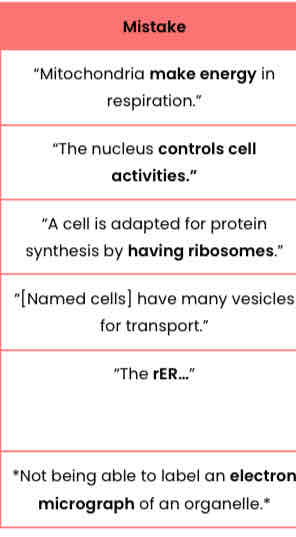
Exam insight: common mistakes
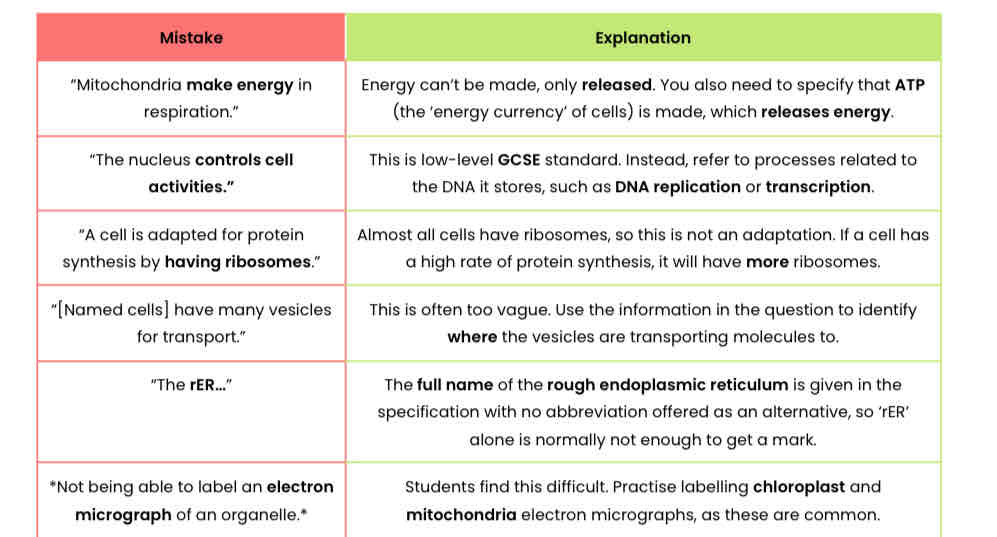
What are the distinguishing features of prokaryotic cells?
● Cytoplasm lacking membrane-bound organelles
● So genetic material not enclosed in a nucleus
Describe the general structure of prokaryotic cells
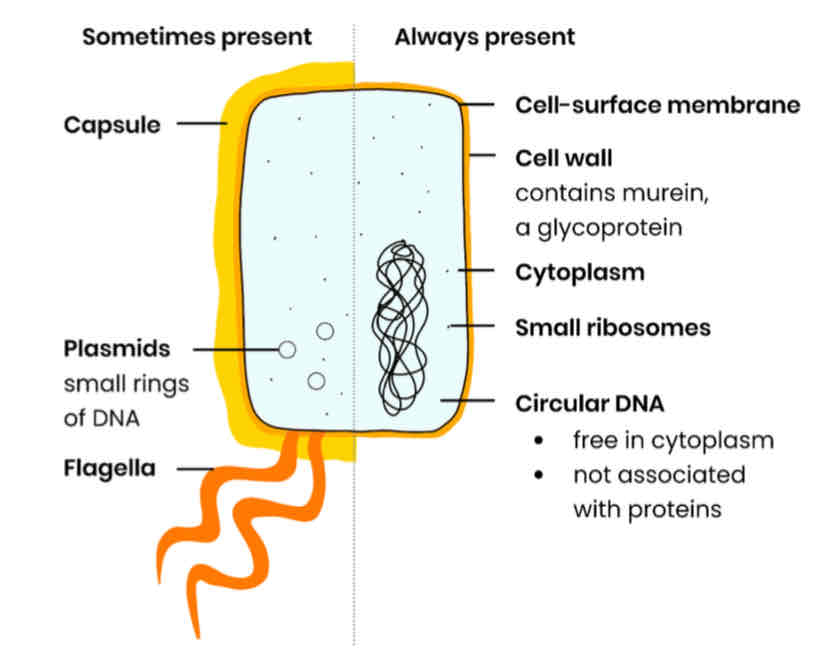
Compare and contrast the structure of eukaryotic and prokaryotic cells
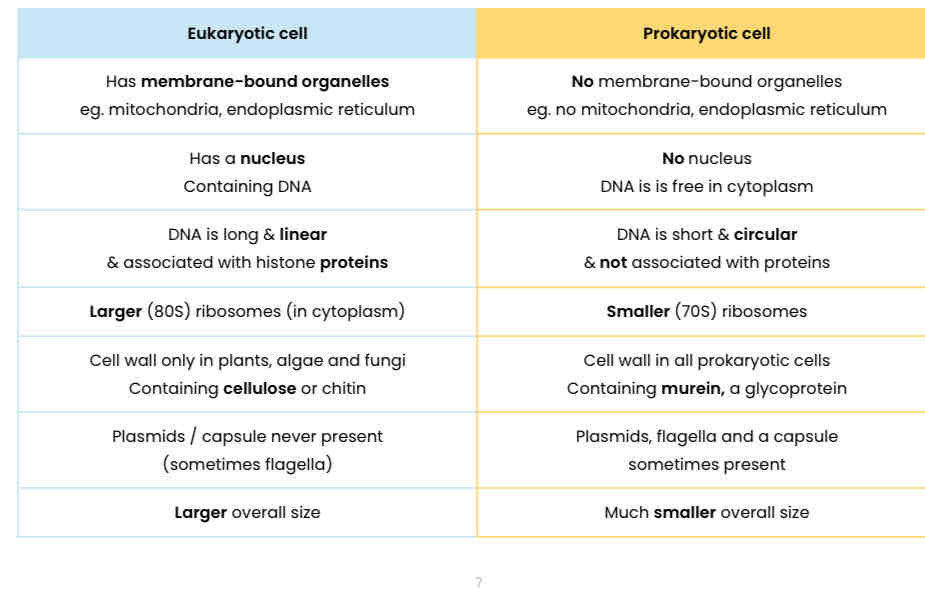
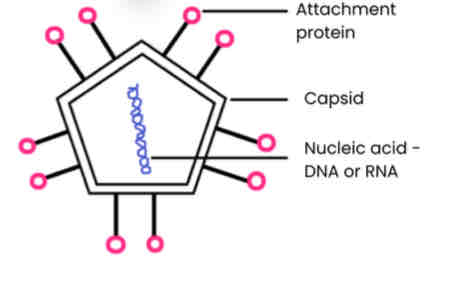
Describe the general structure of a virus particle
1. Nucleic acids surrounded by a capsid (protein coat)
2. Attachment proteins allow attachment to specific host cells
3. No cytoplasm, ribosomes, cell wall, cell-surface membrane etc.
4. Some also surrounded by a lipid envelope eg. HIV
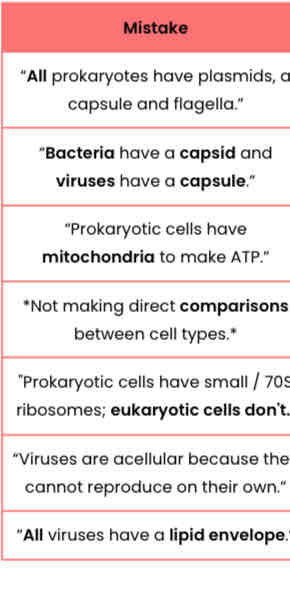
Exam insight: common mistakes
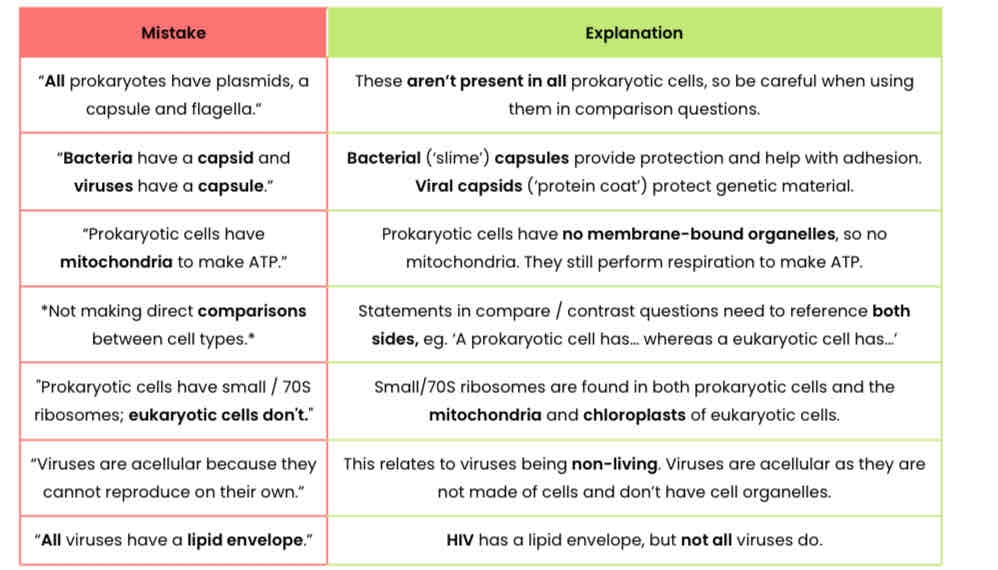
Describe the difference between magnification and resolution
● Magnification = greater image is than size of the real object
○ Magnification = size of image / size of real object
● Resolution = minimum distance apart 2 objects can be to be distinguished as separate objects
List the principles and limitations of optical microscopes
Light focused using glass lenses
Light passes through specimen, different structures absorb different amounts & wavelengths
Generates a 2D image of a cross-section
Low resolution due to long wavelength of light
Can’t see internal structure of organelles or ribosomes
Specimen = thin
Low magnification (x 1500)
Can view living organisms
Can show colour
Simple preparation
List the principles and limitations of Transmission electron microscope (TEM)
Electrons focused using electromagnets
Electrons pass through specimen, denser parts absorb more and appear darker
Generates a 2D image of a cross-section
Very high resolution due to short wavelength of electrons
Can see internal structures of organelles and ribosomes
Specimen = very thin
High magnification (x 1,000,000)
Can only view dead specimens as uses a vacuum
Complex preparation so artefacts often present
Does not show colour
List the principles and limitations of Scanning electron microscope (SEM)
Electrons focused using electromagnets
Electrons bounce off specimen surface
Generates a 3D image of surface
High resolution due to short wavelength of electrons
Can’t see internal structures
Specimen does not need to be thin
High magnification (x 1,000,000)
Can only view dead specimens as uses a vacuum
Complex preparation so artefacts often present
Does not show colour
List the steps in calculations involving magnification, real size & image size
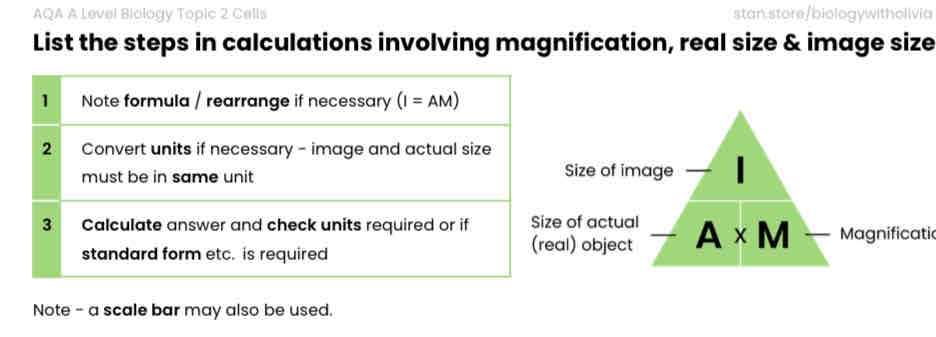
Describe how to convert between different units

Describe how the size of an object viewed with an optical microscope can be measured
Eg. using the stage micrometre to calculate the size of divisions on the eyepiece graticule.
1. Line up (scale of) eyepiece graticule with (scale of) stage micrometre
2. Calibrate eyepiece graticule - use stage micrometre to calculate size of divisions on eyepiece graticule
3. Take micrometre away and use graticule to measure how many divisions make up the object
4. Calculate size of object by multiplying number of divisions by size of division
5. Recalibrate eyepiece graticule at different magnifications
● 4 eyepiece graticule divisions = 10 stage micrometre divisions
● In this stage micrometre, 1 subdivision = 10 μm
● So 4 eyepiece graticule divisions = 10μmx10=100μm
● So 1 eyepiece graticule division = 100 μm/4 = 25 μm
Describe and explain the principles of cell fractionation and ultracentrifugation as used to separate cell components
1. Homogenise tissue / use a blender
● Disrupts cell membrane, breaking open cells and releasing contents / organelles
2. Place in a cold, isotonic, buffered solution
● Cold to reduce enzyme activity → so organelles not broken down / damaged
● Isotonic so water doesn’t move in or out of organelles by osmosis → so they don’t burst
● Buffered to keep pH constant → so enzymes don’t denature
3. Filter homogenate
● Remove large, unwanted debris eg. whole cells, connective tissue
4. Ultracentrifugation - separates organelles in order of density / mass
● Centrifuge homogenate in a tube at a high speed
● Remove pellet of heaviest organelle and respin supernatant at a higher speed
● Repeat at increasing speeds until separated out, each time pellet made of lighter
organelles (nuclei → chloroplasts / mitochondria → lysosomes → ER → ribosomes)
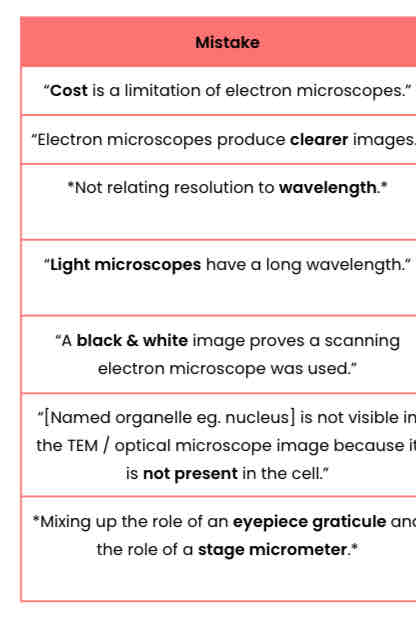
Exam insight: common mistakes
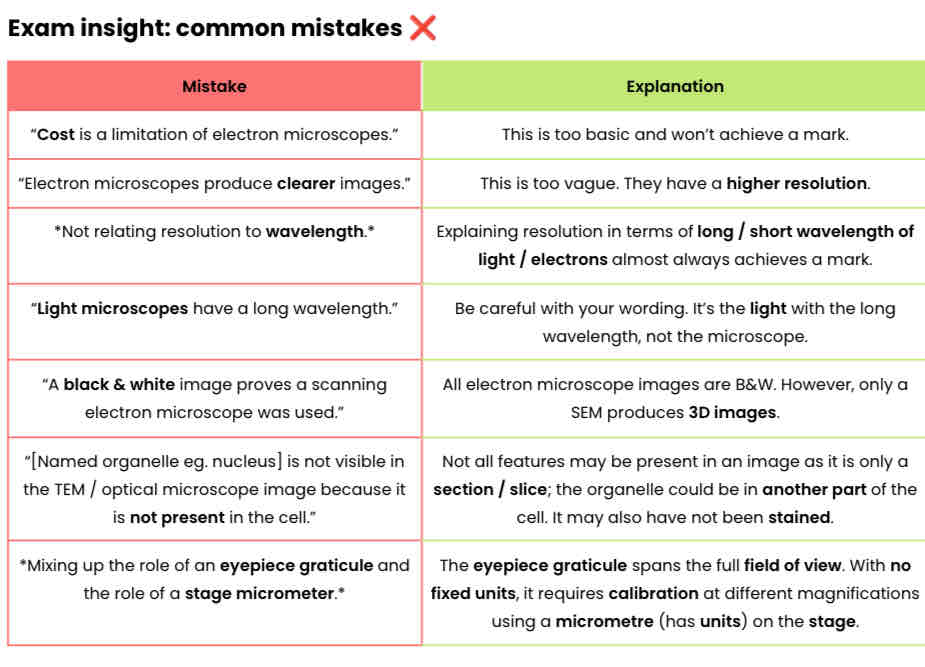
Describe the stages of the cell cycle in eukaryotic cells

Describe the behaviour of chromosomes & role of spindle fibres in mitosis
Students should be able to recognise the stages of the cell cycle and explain the appearance of cells in each stage of mitosis.
This is covered under required practical
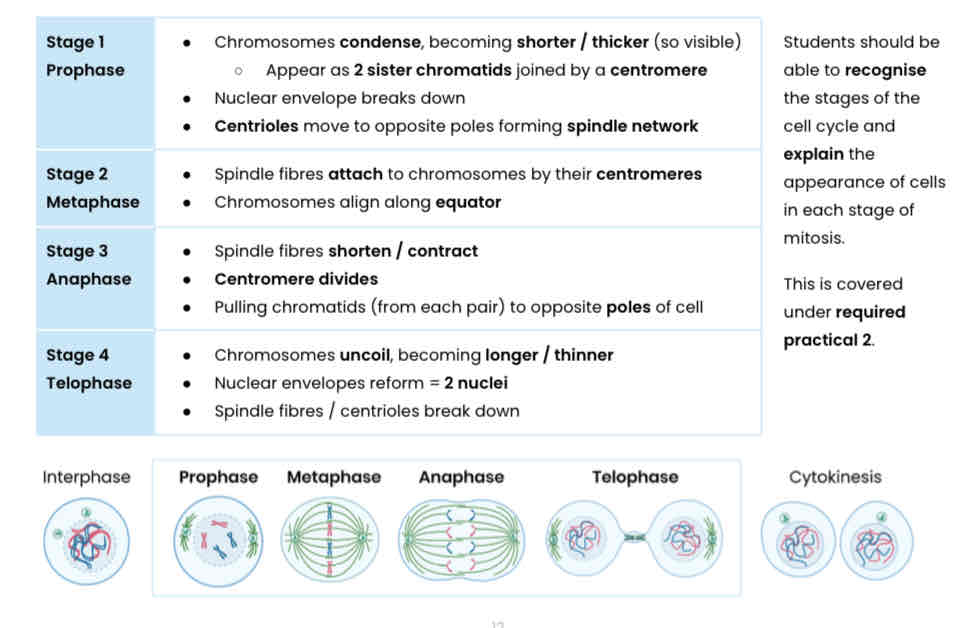
Why do some eukaryotic cells not undergo the cell cycle?
● not all cells have the ability to divide
Explain the importance of mitosis in the life of an organism
Growth of multicellular organisms by increasing cell number
Replacing cells to repair damaged tissues
Asexual reproduction
Describe how tumours and cancers form
Mitosis is a controlled process.
● Mutations in DNA / genes controlling mitosis can lead to uncontrolled cell division
● Tumour formed if this results in mass of abnormal cells
○ Malignant tumour = cancerous, can spread (metastasis)
○ Benign tumour = non-cancerous
Suggest how cancer treatments control rate of cell division
● Some disrupt spindle fibre formation
○ So chromosomes can’t attach to spindle by their centromere
○ So chromatids can’t be separated to opposite poles (no anaphase)
○ So slows mitosis
● Some prevent DNA replication during interphase
○ So can’t make 2 copies of each chromosome (chromatids)
○ So slows mitosis
Describe how prokaryotic cells replicate
Binary Fission:
1. Replication of circular DNA
2. Replication of plasmids
3. Division of cytoplasm to produce 2 daughter cells
● Single copy of circular DNA
● Variable number of copies of plasmids
Describe how viruses replicate
Being non-living, viruses do not undergo cell division.
1. Attachment proteins attach to complementary receptors on host cell
2. Inject viral nucleic acid (DNA/RNA) into host cell
3. Infected host cell replicates virus particles:
a. Nucleic acid replicated
b. Cell produces viral protein / capsid / enzymes
c. Virus assembled then released
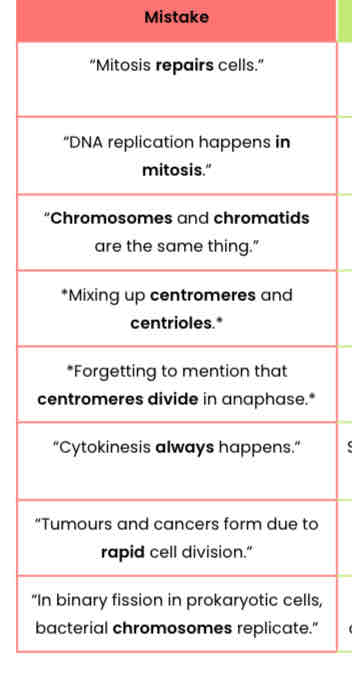
Exam insight: common mistakes
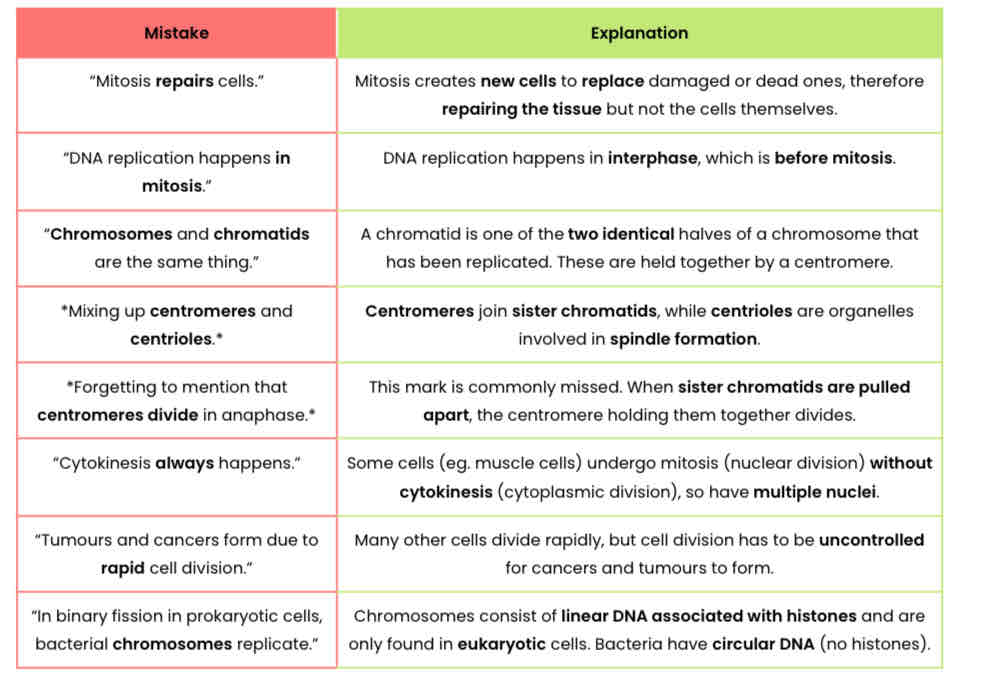
Describe the fluid-mosaic model of membrane structure
The basic structure of all cell membranes (cell-surface membranes & membranes around eukaryotic organelles) is the same.
● Molecules free to move laterally in phospholipid bilayer
● Many components - phospholipids, proteins, glycoproteins and glycolipids
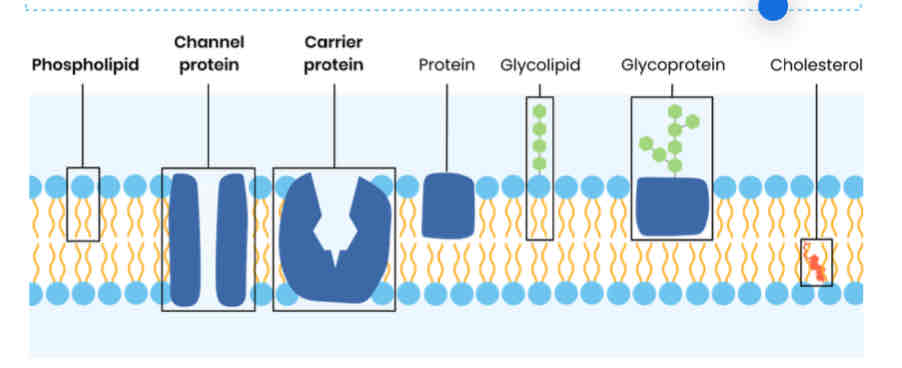
Describe the arrangement of the components of a cell membrane
● Phospholipids form a bilayer - fatty acid tails face inwards, phosphate heads face outwards
● Proteins
○ Intrinsic / integral proteins span bilayer eg. channel and carrier proteins
○ Extrinsic / peripheral proteins on surface of membrane
● Glycolipids (lipids with polysaccharide chains attached) found on exterior surface
● Glycoproteins (proteins with polysaccharide chains attached) found on exterior surface
● Cholesterol (sometimes present) bonds to phospholipid hydrophobic fatty acid tails
Explain the arrangement of phospholipids in a cell membrane
Bilayer, with water present on either side
Hydrophobic fatty acid tails repelled from water so point away from water / to interior
Hydrophilic phosphate heads attracted to water so point to water
Explain the role of cholesterol (sometimes present) in cell membranes
● Restricts movement of other molecules making up membrane
● So decreases fluidity (and permeability) / increases rigidity
Suggest how cell membranes are adapted for other functions
● Phospholipid bilayer is fluid → membrane can bend for vesicle formation / phagocytosis
● Glycoproteins / glycolipids act as receptors / antigens → involved in cell signalling / recognition
Explain the limitations imposed by the nature of the phospholipid bilayer
● Restricts movement of water soluble (polar) & larger substances eg. Na+ / glucose
● Due to hydrophobic fatty acid tails in interior of bilayer
Describe how movement across membranes occurs by facilitated diffusion
● Water-soluble (polar) / slightly larger substances
● Move down a concentration gradient
● Through specific channel / carrier proteins
● Passive - doesn’t require energy from ATP / respiration (only kinetic energy of substances)
Explain the role of carrier and channel proteins in facilitated diffusion
● Shape / charge of protein determines which substances move
● Channel proteins facilitate diffusion of water-soluble substances
○ Hydrophilic pore filled with water
○ May be gated - can open / close
● Carrier proteins facilitate diffusion of (slightly larger) substances
○ Complementary substance attaches to binding site
○ Protein changes shape to transport substance
Describe how movement across membranes occurs by osmosis
Water potential is a measure of how likely water molecules are to move out of a solution. Pure (distilled) water has the maximum possible ψ (0 kPA), increasing solute concentration decreases ψ.
● Water diffuses / moves
● From an area of high to low water potential (ψ) / down a water potential gradient
● Through a partially permeable membrane
● Passive - doesn’t require energy from ATP / respiration (only kinetic energy of substances)
Describe how movement across membranes occurs by active transport
● Substances move from area of lower to higher concentration / against a concentration gradient
● Requiring hydrolysis of ATP and specific carrier proteins
Describe the role of carrier proteins and the importance of the hydrolysis of ATP in active transport
1. Complementary substance binds to specific carrier protein
2. ATP binds, hydrolysed into ADP + Pi, releasing energy
3. Carrier protein changes shape, releasing substance on side of higher concentration
4. Pi released → protein returns to original shape
Describe how movement across membranes occurs by co-transport
2 substances bind to a co-transporter protein
one substance moves against its concentration gradient and another moves down its concentration gradient
Describe an example that illustrates co-transport
Absorption of sodium ions and glucose (or amino acids) by cells lining the mammalian ileum:
● Na+ actively transported from epithelial cells to blood (by Na+/K+ pump)
● Establishing a conc. gradient of Na+ (higher in lumen than epithelial cell)
● Na+ enters epithelial cell down its concentration gradient with glucose against its concentration gradient
● Via a co-transporter protein
● Glucose moves down a conc. gradient into blood via facilitated diffusion
The movement of sodium can be considered indirect / secondary active transport, as it is reliant on a concentration gradient established by active transport.
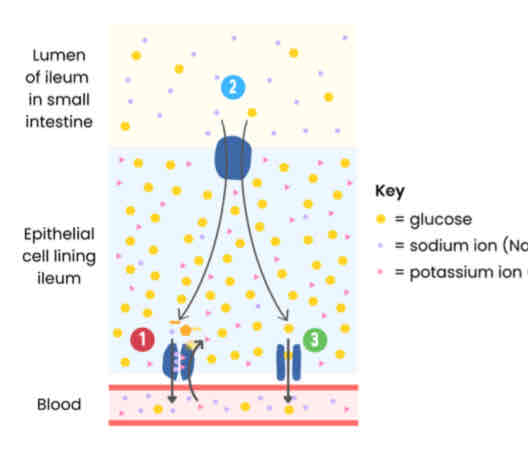
Describe how surface area, number of channel or carrier proteins and differences in gradients of concentration or water potential affect the rate of movement across cell membranes
● Increasing surface area of membrane increases rate of movement
● Increasing number of channel / carrier proteins increases rate of facilitated diffusion / active transport
● Increasing concentration gradient increases rate of simple / facilitated diffusion and osmosis
● Increasing concentration gradient increases rate of facilitated diffusion
○ Until number of channel / carrier proteins becomes a limiting factor as all in use / saturated ● Increasing water potential gradient increases rate of osmosis
Explain the adaptations of some specialised cells in relation to the rate of transport across their membranes
● Membrane folded eg. microvilli in ileum → increase in surface area
● More protein channels / carriers → for facilitated diffusion (or active transport - carrier proteins only)
● Large number of mitochondria → more ATP by aerobic respiration for active transport
What is an antigen?
● Foreign molecule / protein / glycoprotein / glycolipid
● That stimulates an immune response leading to production of antibody
How are cells identified by the immune system?
● Each type of cell has specific molecules on its surface (cell-surface membrane / cell wall) that identify it
● Often proteins → have a specific tertiary structure (or glycoproteins / glycolipids)
What types of cells and molecules can the immune system identify?
1. Pathogens (disease causing microorganisms) eg. viruses, fungi, bacteria
2. Cells from other organisms of the same species (eg. organ transplants)
3. Abnormal body cells eg. tumour cells or virus-infected cells
4. Toxins (poisons) released by some bacteria
Describe phagocytosis of pathogens (non-specific immune response)
Phagocyte attracted by chemicals / recognises (foreign) antigens on pathogen
Phagocyte engulfs pathogen by surrounding it with its cell membrane
Pathogen contained in vesicle / phagosome in cytoplasm of phagocyte
Lysosome fuses with phagosome and releases lysozymes (hydrolytic enzymes)
Lysozymes hydrolyse / digest pathogen
What does phagocytosis lead to?
presentation of antigens where antigens are displayed on the phagocyte cell-surface membrane, stimulating the specific immune response (cellular and humoral response).
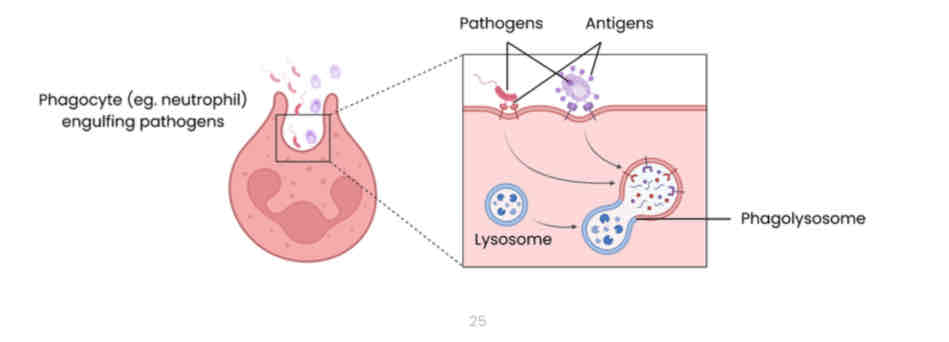
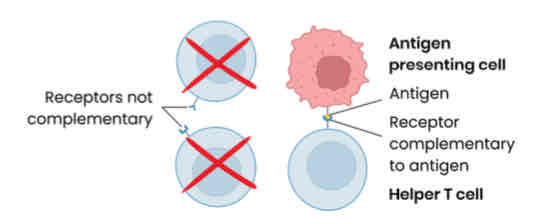
Describe the response of T lymphocytes to a foreign antigen (the cellular response)
T lymphocytes recognise (antigens on surface of) antigen presenting cells eg. infected cells, phagocytes presenting antigens, transplanted cells, tumour cells etc.
Specific helper T cells with complementary receptors bind to antigen on antigen-presenting cell → activated & divide by mitosis forming clones stimulating:
● Cytotoxic T cells → kill infected cells / tumour cells (by producing perforin)
● Specific B cells (humoral response - see below)
● Phagocytes → engulf pathogens by phagocytosis
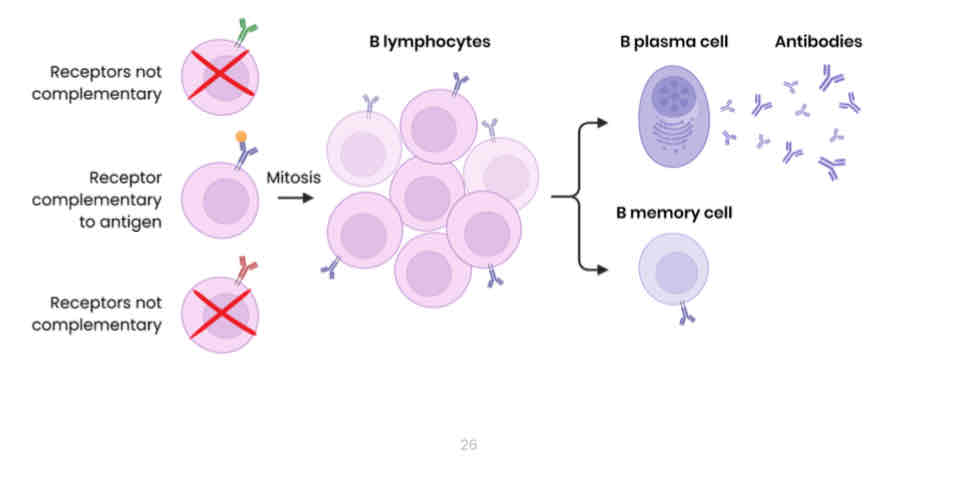
Describe the response of B lymphocytes to a foreign antigen (the humoral response)
B lymphocytes can recognise free antigens eg. in blood or tissues, not just antigen presenting cells.
1. Clonal selection:
● Specific B lymphocyte with complementary receptors binds to antigen
● then stimulated by helper T cells (which releases cytokines)
● So divides (rapidly) by mitosis forming clones
2. Some differentiate into B plasma cells → secrete large amounts of (monoclonal) antibody
3. Some differentiate into B memory cells → remain in blood for secondary immune response
What are antibodies?
● Quaternary structure proteins (4 polypeptide chains)
● Secreted by B lymphocytes eg. plasma cells in response to specific antigens
● Bind specifically to antigens forming antigen-antibody complexes
Describe the structure of an antibody
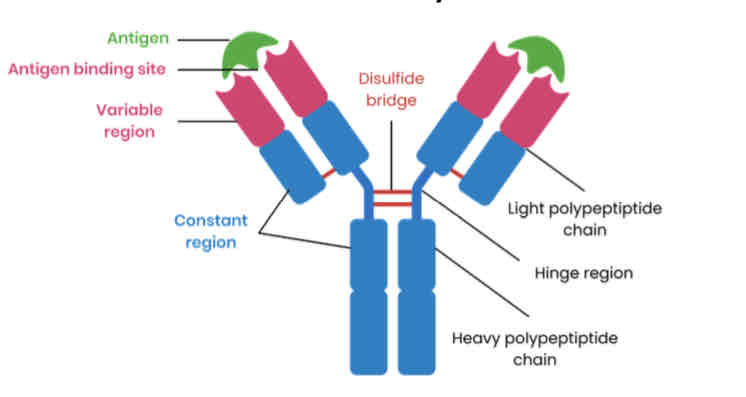
Explain how antibodies lead to the destruction of pathogens
● Antibodies bind to antigens on pathogens forming an antigen-antibody complex
○ Specific tertiary structure so binding site binds to complementary antigen
● Each antibody binds to 2 pathogens at a time causing clumping of pathogens
● Antibodies attract phagocytes
● Phagocytes bind to the antibodies and phagocytose many pathogens at once
What is a vaccine?
● Injection of antigens from weakened pathogens
● Stimulating memory cells
Explain how vaccines provide protection to individuals against disease
Specific T helper cell binds to antigen-presenting cell and stimulates B cell
Specific B lymphocyte with complementary receptor binds to antigen
B lymphocyte divides by mitosis to form clones
Some differentiate into B plasma cells which release antibodies
Some differentiate into B memory cells
On secondary exposure to antigen, B memory cells rapidly divide by mitosis to produce B plasma cells
release antibodies faster at a higher concentration
Explain how vaccines provide protections for populations against disease
● Herd immunity - large proportion of population vaccinated, reducing spread of pathogen
○ Large proportion of population immune so do not become ill from infection
○ Fewer infected people to pass pathogen on / unvaccinated people less likely to come in contact with someone with disease
Describe the differences between active and passive immunity
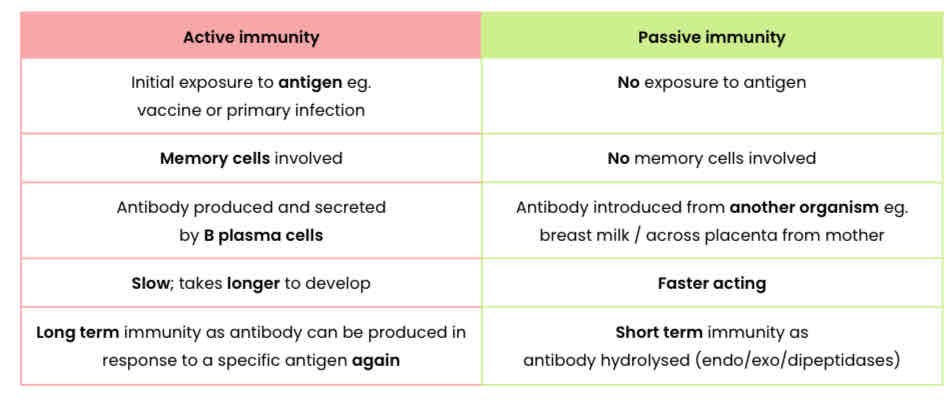
Explain the effect of antigen variability on disease and disease prevention
● Antigens on pathogens change tertiary structure due to gene mutations
● So no longer immune
○ B memory cell receptors cannot bind to antigen on secondary exposure
○ Specific antibodies cannot bind to changed antigen
Describe the structure of a HIV particle
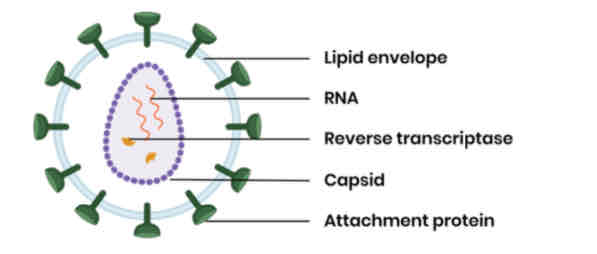
Describe the replication of HIV in helper T cells
1. HIV attachment proteins attach to receptors on helper T cell
2. Lipid envelope fuses with cell-surface membrane, releasing capsid into cell
3. Capsid uncoats, releasing RNA and reverse transcriptase
4. Reverse transcriptase converts viral RNA to DNA
5. Viral DNA inserted into helper T cell DNA
6. Viral protein produced
a. DNA transcribed into HIV mRNA
b. HIV mRNA translated into new HIV proteins
7. Virus particles assembled and released from cell
Explain how HIV causes symptoms of AIDS
● HIV infects and kills helper T cells as it multiplies rapidly
○ T helper cells can’t stimulate cytotoxic T cells, B cells and phagocytes
○ B plasma cells can’t release as many antibodies for agglutination & destruction of pathogens
● Immune system deteriorates → more susceptible to infections
● Pathogens reproduce, release toxins and damage cells
Explain why antibiotics are ineffective against viruses
Viruses do not have structures that antibiotics inhibit:
Viruses do not have metabolic processes (eg. do not make protein) / ribosomes
Viruses do not have murein cell wall
What is a monoclonal antibody?
● Antibody produced from cloned B lymphocytes / plasma cells
● So have same tertiary structure
Explain how monoclonal antibodies can be used in medical treatments
● Monoclonal antibody has a specific tertiary structure
● Complementary to receptor found only on a specific cell type (eg. cancer cell)
● Therapeutic drug attached to antibody
● Antibody binds to specific cell, forming antigen-antibody complex, delivering drug
Explain how monoclonal antibodies can be used in medical diagnosis
● Monoclonal antibody has a specific tertiary structure / binding site / variable region
● Complementary to specific receptor / protein / antigen
● Dye / stain / fluorescent marker attached to antibody
● Antibody binds to receptor / protein / antigen, forming antigen-antibody complex

Explain the use of antibodies in the ELISA (enzyme-linked immunosorbent assay) test to detect antigens
Direct ELISA
1. Attach sample with potential antigens to well
2. Add complementary monoclonal antibodies with enzymes attached → bind to antigens if present
3. Wash well → remove unbound antibodies (to prevent false positive)
4. Add substrate → enzymes create products that cause a colour change (positive result)
OR sandwich ELISA
1. Attach specific monoclonal antibodies to well
2. Add sample with potential antigens, then wash well
3. Add complementary monoclonal antibodies with enzymes attached → bind to antigens if present
4. Wash well → remove unbound antibodies (to prevent false positive)
5. Add substrate → enzymes create products that cause a colour change (positive result)

Explain the use of antibodies in the ELISA test to detect antibodies
Indirect ELISA:
1. Attach specific antigens to well
2. Add sample with potential antibodies, wash well
3. Add complementary monoclonal antibodies with enzymes attached → bind to antibodies if present
4. Wash well → remove unbound antibodies
5. Add substrate → enzymes create products that cause a colour change (positive result)
Suggest the purpose of a control well in the ELISA test
● Compare to show only enzyme causes colour change
● Compare to show all unbound antibodies have been washed away
Discuss some general ethical issues associated with the use of vaccines and monoclonal antibodies
● Pre-clinical testing on / use of animals - potential stress / harm / mistreatment
○ But animals not killed & helps produce new drugs to reduce human suffering
● Clinical trials on humans - potential harm / side-effects
● Vaccines - may continue high risk activities and still develop / pass on pathogen
● Use of drug - potentially dangerous side effects
Suggest some points to consider when evaluating methodology relating to the use of vaccines and monoclonal antibodies
● Was the sample size large enough to be representative?
● Were participants diverse in terms of age, sex, ethnicity and health status?
● Were placebo / control groups used for comparison?
● Was the duration of the study long enough to show long-term effects?
● Was the trial double-blind (neither doctor / patient knew who was given drug or placebo) to reduce bias?
Suggest some points to consider when evaluating evidence and data relating to the use of vaccines and monoclonal antibodies
● What side effects were observed, and how frequently did they occur?
● Was a statistical test used to see if there was a significant difference between start & final results?
● Was the standard deviation of final results large, showing some people did not benefit?
● Did standard deviations of start & final results overlap, showing there may not be a significant difference?
● What dosage was optimum? Does increasing dose increase effectiveness enough to justify extra cost?
● Was the cost of production & distribution low enough?
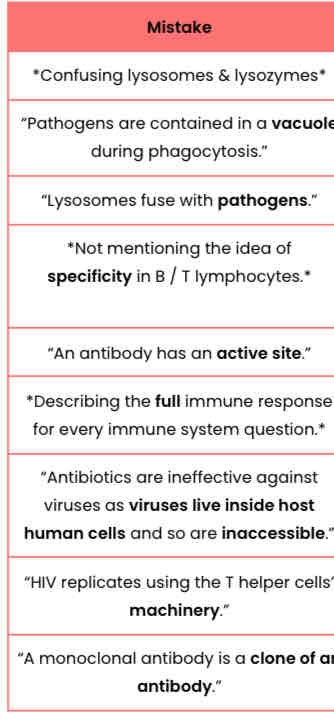
Exam insight: common mistakes
